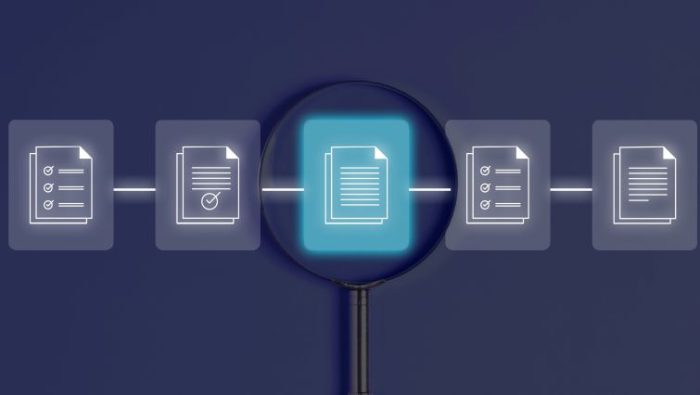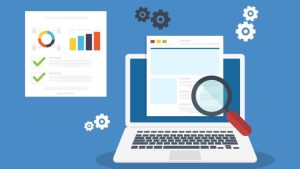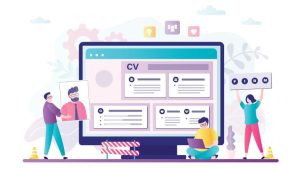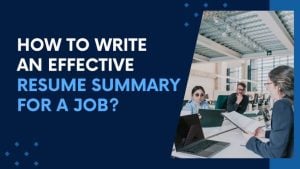How To Create a Resume in the New AI Recruiting Age
 Publié le 3 April 2023
Publié le 3 April 2023
Beat the algorithm and get your dream job by knowing how to create a resume in the new AI recruiting age.
Practically every job hunt starts online. Candidates submit a resume, wait for a response, and, if they are lucky, go to an interview to speak to HR agents in person. But these days, there’s a new twist in the mix: AI recruiting tools, which can make some candidates’ resumes fail at the starting line, even if they look ideal for a given job position.
If you’ve found yourself out of luck when it comes to job-hunting in the digital age, you’ve come to the right place. We’ll explain step-by-step how to create a resume in the AI recruiting age .
The Rise of AI Recruiting and What It Means for Jobseekers
Regardless of industry, recruitment involves a lot of repetitive and time-consuming work. This includes scanning resumes, accepting work applications, filtering through the “automatic nos” or bad resumes, etc. All of that takes valuable time and energy out of HR representatives, who have additional important things to do, like interviewing candidates and helping companies meet their social initiatives.
AI technology isn’t as advanced as some science fiction authors might like to imagine. But it’s certainly powerful enough to take away a lot of rote and monotonous work out of the hands of human resources workers. Even better, AI tools and software platforms can do that work faster and more accurately.
AI recruiting tools let organizations improve and streamline their hiring practices by:
- Identifying qualified candidates based on resume keywords
- Funneling the best potential candidates to HR representatives for further review
- Sourcing additional candidates by browsing job seeker sites and job boards, etc.
On top of that, AI software can make candidates’ recruiting experiences a little better, as well. They can make it easier for job seekers to apply for new positions, streamline communications with a hiring company, and track job apps and their progress.
The Problems With AI Recruiting
That all said, the trend of AI handling recruitment in HR does have its downsides. For one, AI can’t really tell a good resume apart from a bad one. All it can do is determine which resumes have certain quantities of keywords. This is a poor proxy for a comprehensive human analysis.
Secondly, AI is unable to properly or compellingly test job candidates in a way that can prove they’re fit for a job interview. Instead, AI software tools have to rely on clunky tests like pattern assessments, memory exams, and similar metrics.
This has led to several modern problems for present-day job seekers. They often apply to many different positions, only to find that the application process is confusing or that their resumes are turned away, despite having (on paper) everything that the prospective employer is looking for. In many cases, it’s all because an AI can’t read through their resumes accurately.
According to a professor at Harvard Business School, Joe Fuller, 88% of business executives using AI-driven software and recruitment tools know that those tools reject qualified candidates all the time. This can lead to poor outcomes for diversity, equity, and inclusion initiatives – Amazon, for example, discovered that its resume screening tool was inadvertently biased against female applicants.
Do All Companies Use AI for Recruitment These Days?
Although it’s becoming more popular and common every day, not all companies use AI recruiting tools. But as noted above, the primary draw to these tools is cutting down on the time human workers have to spend on monotonous or repetitive tasks, like filtering out bad resumes from application spammers.
Those benefits are simply too attractive for companies to give up AI recruiting software outright. Because of this, modern job seekers need to be aware of the changing recruitment landscape and know how to tailor their resumes to better suit the robot screeners they’re likely to encounter.
Drafting a Modern Resume To Maximize Your Chances of Getting Hired
It doesn’t matter what industry you’re hunting for a job in. You still need to draft an excellent, attractive resume that can pass AI screeners and draw the attention of human recruiters. After all, resumes and job candidates that get past AI tools are funneled to the desks of HR specialists, who will handle your interview and decide whether you’ll get the job.
Thus, you have to ensure your resume is optimized for AI and for people. Here are some tips for how you can create a resume in the new AI recruiting age that you can use to maximize your chances of getting hired.
Make Your Resume “Machine-Readable”
First and foremost, you should make your resume as machine-readable as possible. There are a few principles to keep in mind as you go through your resume and redraft it with this mindset:
- First, your resume should include no special characters, images, or anything other than plaintext. That includes ampersands and tildes, which can mess up some AI tools or make AI screens not understand the information you are presenting.
- Next, your resume should use the most basic, common template possible. The template should include your contact information on top, a bullet list of your skills in specializations, and only a few wrap-up sentences.
- When it comes to text, a good machine-readable resume will use short, crisp, plain sentences. These should be declarative, quantitative, and utterly simple. Try to avoid adjectives or words that aren’t necessary. Cut out anything that an AI tool would disregard in its keyword search of your document.
- Cut out extensive introductions and flowery conclusions. If you do decide to include a personal brand statement to highlight and summarize your skills and work experience, keep it to two or three short sentences at most.
- Try to use bullet lists as much as you can. AI tools can read paragraphs competently, but if you present the most important information in a bullet list, it’ll be much faster to read. Plus, the AI will pick out your target keywords much more accurately and consistently.
Note that when you first read your completed AI-ready resume, it will probably seem dry, uninteresting, and bad to you. That’s because you’re a person, and you prefer text on a resume to be readable and at least a little interesting (while still getting to the point).
AI tools are different. The more information you can provide on one or two pages, and the more concise that information is, the better. Stick with these pointers, and your resume will pass many more AI tools than it did previously.
Prioritize Qualifications and Licenses
The next big tip goes for any resume, not just one that you anticipate drifting under the digital eye of artificial intelligence. List your qualifications and licenses and put them in a place of priority on your resume document, such as in the middle and toward the top.
Recruiters love qualifications and licenses, especially when you have far more than the next most attractive candidate. Certificates you earned from taking extra classes in school can make or break your job application when plenty of other applicants are roughly the same as you in terms of education and job experience.
Furthermore, qualifications and licenses are some of the most important things AI tools look for when scanning resumes. AI tools can’t really tell whether one candidate or another will be better for a given company. But they can directly measure how many qualifications and licenses one person has compared to another.
Even if a qualification or license doesn’t seem especially important, list it; as it still confirms your commitment to gaining new knowledge that will help you improve your performance in the workplace .
Utilize Online Resume Scanners
As you put together your AI-ready resume, you’ll want to make sure that it’s actually up for the task. Fortunately, you can test your resume with other AI tools.
Upload your resume, in addition to the job description you wish to apply for, to an automatic resume checker. Some good examples include:
- Jobscan, which scores your resume based on how well it matches a given job description and offers optimization assistance for every employer in its database. This tool is free, but you only have access to two scans and calculations per month.
- VMock, which offers resume feedback to users by highlighting inconsistencies and simplifying sentence descriptions. This can be an excellent tool if you want to identify transferable skills to help you buff up your resume and make it look much thicker than it might feel.
Submit your resume to one of these scanners and tools to use AI against AI. After all, these tools will catch many of the same things that your recruiters’ AI software will be looking for, so consider them effective litmus tests for the quality of your resume.
Match Your Resume Content to Keyword in the Job Description
Every job you apply for will have a detailed job description. More and more descriptions these days are either written or optimized by AI, so they include a host of keywords. Note those keywords: they’re usually easily identified by being bolded, italicized, capitalized, or listed in a bullet point sequence.
For example, imagine you see a job description with a sentence and bullet list like this:
“We’re looking for a talented individual who can showcase the following skills:
- Communicative
- Team player
- Hard worker
- Friendly”
That list likely contains some of the major keywords the employer has trained the AI to look for. So, while tinkering with your resume for this specific job application, be sure to include words like communicative, team player, and friendly in your description or skills list.
That’s another note: each resume you create should be tweaked for each job you apply to. That’s a good rule of thumb for any job hunt, even without AI in the mix. But it’s especially important when preparing your resume for AI screening, as each AI tool will look for slightly different things, like keywords, in every applicant’s paperwork.
Make a Resume for Humans
Another tip you should keep in mind when making a resume for AI recruitment software: copy it, then tweak the resume and make a new version for human eyes.
Why? Because recruiters know very well that AI-ready resumes are difficult to read or don’t give a full picture of a candidate’s competency or suitability for a given position. And they may request another copy of your CV. You can also use your cover letter to provide a more in-depth – and human – look at your professional skills and experiences that make you the ideal candidate for the job.
You can impress those recruiters by giving them a resume with flowing, better-constructed sentences and fewer unnecessary bullet points. It shows that you know the current job landscape (highlighting your intelligence), plus it gives the HR team less work to do and makes their jobs a little easier. If you struggle with creativity, you can also consider hiring a freelance writer to help write your resume for a bit of assistance.
Add Relevant Skills, Even if Not Asked For
It’s also wise to add as many relevant skills and traits as possible to your resume and job application. This ties into the above advice about listing certifications and licenses. Even if you don’t think a particular skill is noteworthy, put it on your resume, so the AI gives you another point over a competitor.
For instance, say that you are applying for an entry-level administrative job. The job description doesn’t request proficiency in Microsoft Office for job candidates. But if you already know how to use Microsoft Word, there’s no harm in listing “Microsoft Office competency” as one of your core skills. The AI will use this to bump your resume to the top of the proverbial list, and a human employer may very well consider that to be a bonus, as well.
Wrap Up
AI recruitment tools aren’t going away anytime soon. If you are looking for a job, your best path to success isn’t to fight against this trend; it’s to recognize it and adapt accordingly. Keep these tips in mind for how to create a resume in the new AI recruiting age, and your job hunt will go much more smoothly.







